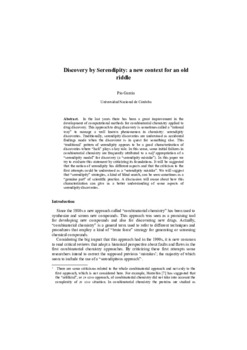| dc.contributor.author | Garcia, Pío | |
| dc.date.accessioned | 2015-02-09T19:44:43Z | |
| dc.date.available | 2015-02-09T19:44:43Z | |
| dc.date.issued | 2015-02-09 | |
| dc.identifier.uri | http://hdl.handle.net/11086/1695 | |
| dc.description.abstract | In the last years there has been a great improvement in the
development of computational methods for combinatorial chemistry applied to
drug discovery. This approach to drug discovery is sometimes called a “rational
way” to manage a well known phenomenon in chemistry: serendipity
discoveries. Traditionally, serendipity discoveries are understood as accidental
findings made when the discoverer is in quest for something else. This
‘traditional’ pattern of serendipity appears to be a good characterization of
discoveries where “luck” plays a key role. In this sense, some initial failures in
combinatorial chemistry are frequently attributed to a naïf appropriation of a
“serendipity model” for discovery (a “serendipity mistake”). In this paper we
try to evaluate this statement by criticizing its foundations. It will be suggested
that the notion of serendipity has different aspects and that the criticism to the
first attempts could be understood as a “serendipity mistake”. We will suggest
that “serendipity” strategies, a kind of blind search, can be seen sometimes as a
“genuine part” of scientific practice. A discussion will ensue about how this
characterization can give us a better understanding of some aspects of
serendipity discoveries. | es |
| dc.language.iso | spa | es |
| dc.rights | Atribución-NoComercial-SinDerivadas 2.5 Argentina | * |
| dc.rights.uri | http://creativecommons.org/licenses/by-nc-nd/2.5/ar/ | * |
| dc.title | Discovery by Serendipity: a new context for an old riddle | es |
| dc.type | article | es |
| dc.description.version | publishedVersion | es |





